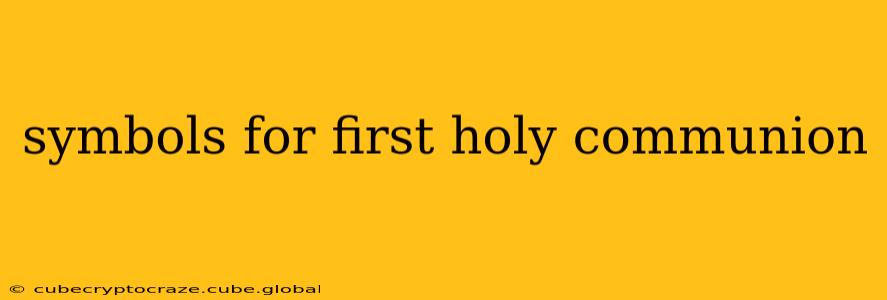First Holy Communion is a deeply significant event in the Catholic faith, marking a child's first reception of the Eucharist. This special occasion is often rich with symbolism, reflecting the spiritual journey and the profound meaning of the sacrament. Understanding these symbols can enrich the experience for both the communicant and their family. This article explores the most common symbols and their significance, answering frequently asked questions about their meaning and importance.
What are the main symbols of First Holy Communion?
The most prominent symbols associated with First Holy Communion often revolve around the Eucharist itself and the journey towards receiving it. These include:
-
The Eucharist (The Bread and Wine): This is the central symbol, representing the body and blood of Christ. It's the reason for the celebration and signifies the spiritual nourishment and union with God that the child now partakes in.
-
The Dove: Symbolizing the Holy Spirit, the dove represents God's presence and guidance in the communicant's life. It's a symbol of peace, purity, and love, reflecting the grace received through the Eucharist.
-
The Lamb: Often depicted as a sacrificial lamb, this symbol represents Jesus Christ, the ultimate sacrifice for humanity's salvation. The lamb’s innocence and purity connects to the child’s own journey of faith.
-
The Cross: This powerful symbol is a constant reminder of Christ's sacrifice and the love that underlies the sacrament. The cross serves as a symbol of hope, redemption, and the enduring power of faith.
-
Candles: Lit candles often represent the light of Christ illuminating the communicant’s path. They symbolize faith, hope, and the spiritual enlightenment the child receives.
-
White Garment: Traditionally, the communicant wears a white garment, symbolizing purity, innocence, and the new life in Christ that the sacrament represents. It's a visible representation of the inner transformation.
What does the white dress/suit symbolize in First Holy Communion?
As mentioned above, the white garment (dress or suit) symbolizes the purity and innocence associated with the sacrament. White represents new beginnings, cleansing, and the child's newly strengthened commitment to God. It reflects the spiritual cleanliness and fresh start that comes with receiving the Eucharist.
What does the dove symbolize in First Holy Communion?
The dove symbolizes the Holy Spirit, a crucial element in the Trinity. The Holy Spirit is seen as the guiding force in the communicant's life, offering comfort, wisdom, and strength on their journey of faith. It also represents peace and the divine love that encompasses the celebration.
What flowers are used in First Holy Communion?
While there isn't a single set of "official" flowers, lilies are frequently used. Lilies symbolize purity, innocence, and new beginnings, all of which resonate deeply with the themes of First Holy Communion. Other white flowers, such as roses or daisies, are also popular choices. The choice often reflects personal preference and the overall aesthetic of the celebration.
What is the significance of the Bible in First Holy Communion?
The Bible, particularly the Gospels, holds immense significance. It contains the teachings and life of Jesus Christ, the foundation of the Catholic faith and the Eucharist itself. The Bible serves as a guide for the child’s spiritual development and a source of wisdom and guidance throughout their life.
Conclusion:
The symbols of First Holy Communion are rich in meaning and help to convey the profound spiritual experience of the sacrament. By understanding the symbolism, families and communicants alike can gain a deeper appreciation for the significance of this pivotal moment in the life of a Catholic child. The celebration transcends a mere ritual; it marks the beginning of a lifelong journey of faith, guided by the symbols and the grace received.
